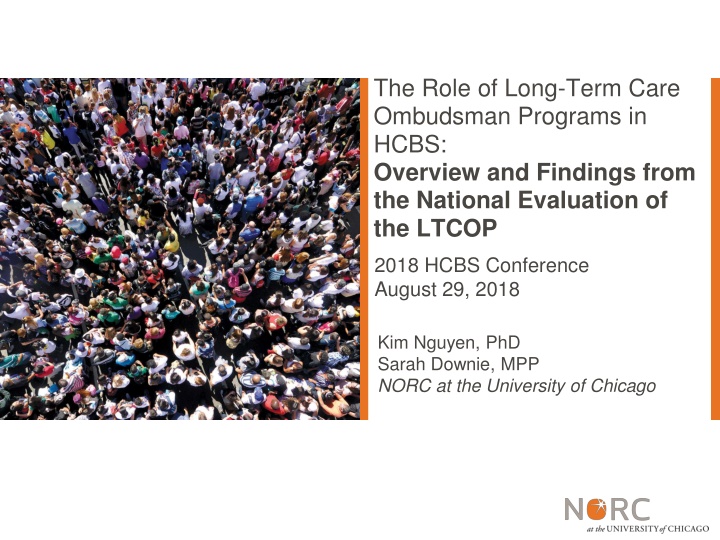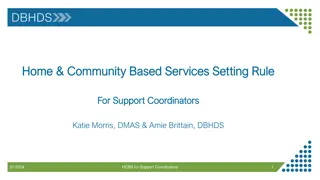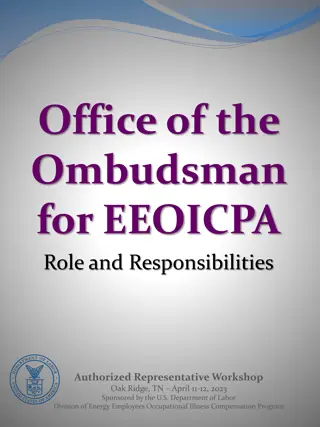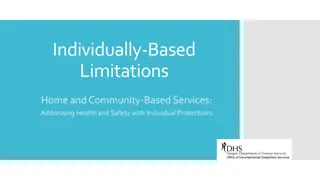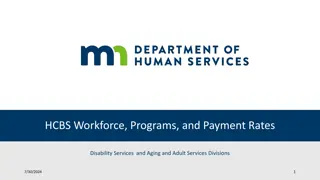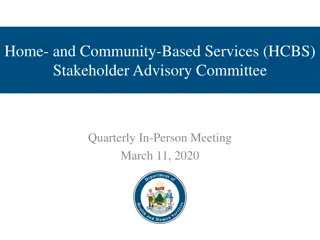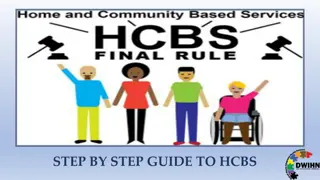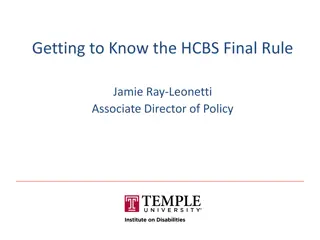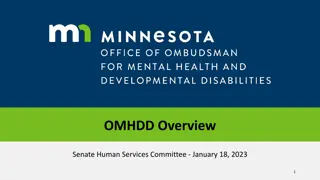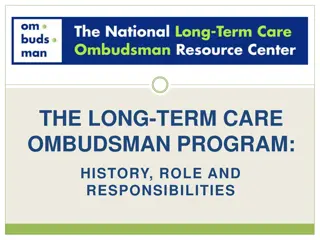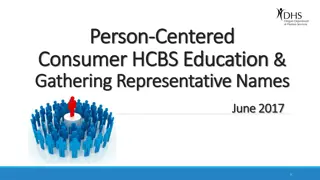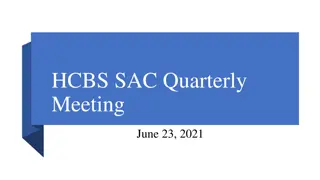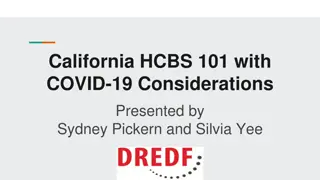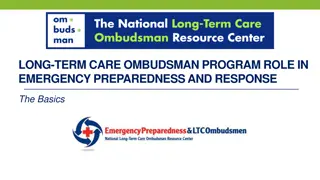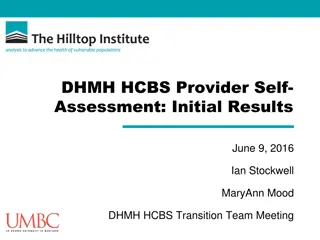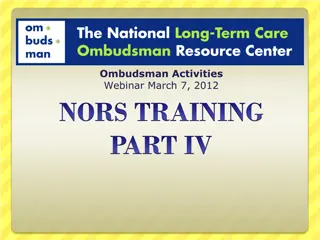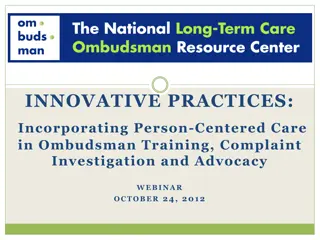The Role of Long-Term Care Ombudsman Programs in HCBS: Overview and Findings
Long-Term Care Ombudsman Programs (LTCOP) advocate for residents in long-term care facilities by investigating and resolving complaints, providing information, and advocating for systemic improvements. This evaluation study delves into the structure and operations of LTCOP at local, state, and federal levels, examining their efficacy in utilizing resources to address individual resident issues and drive facility and community changes.
Download Presentation

Please find below an Image/Link to download the presentation.
The content on the website is provided AS IS for your information and personal use only. It may not be sold, licensed, or shared on other websites without obtaining consent from the author.If you encounter any issues during the download, it is possible that the publisher has removed the file from their server.
You are allowed to download the files provided on this website for personal or commercial use, subject to the condition that they are used lawfully. All files are the property of their respective owners.
The content on the website is provided AS IS for your information and personal use only. It may not be sold, licensed, or shared on other websites without obtaining consent from the author.
E N D
Presentation Transcript
The Role of Long-Term Care Ombudsman Programs in HCBS: Overview and Findings from the National Evaluation of the LTCOP 2018 HCBS Conference August 29, 2018 Kim Nguyen, PhD Sarah Downie, MPP NORC at the University of Chicago
Overview of LTCOP A long-term care Ombudsman (representative of the Office) is an advocate for residents of long-term care facilities. Each state has an Office of the Long-Term Care Ombudsman that is led by a State Long-Term Care Ombudsman (SLTCO) 53 programs, including Guam, Puerto Rico, and Washington DC. Many programs rely on volunteers to maintain an ongoing presence in facilities 3
Overview of LTCOP As authorized by the Older Americans Act (OAA), the Long-Term Care Ombudsman Program (LTCOP) has the following responsibilities: Identify, investigate, and resolve complaints made by or on behalf of residents of long-term care facilities Provide information to residents, families, staff Advocate for systemic changes to improve residents care and quality of life 4
Evaluation Team Process Evaluation and Special Studies Related to the LTCOP NORC at the University of Chicago (NORC Chicago) National Consumer Voice for Quality Long-Term Care (Consumer Voice) Brooke Hollister, PhD, University of California, San Francisco Helaine Resnick, PhD, Resnick, Chodorow and Associates William Benson, Health Benefits ABCs Human Services Research Institute (HSRI) 5
Background Overview of National Studies on the LTCOP 1993-1995: Institute of Medicine (IOM) completed the first national evaluation of the LTCOP. 2011-2013: NORC and its partners developed a comprehensive evaluation design of the LTCOP. 2015-2018: NORC and its partners are conducting a process evaluation of the LTCOP. 2018-2021: NORC and its partners are conducting an outcome evaluation of the LTCOP. 6
Research Questions Process Evaluation and Special Studies Related to the LTCOP How is the LTCOP structured and how does it operate at the local, State, and Federal levels? How do LTCOPs use existing resources to resolve problems of individual residents and to bring about changes at the facility and local, State, and Federal levels that will improve the quality of services available/ provided? With whom do LTCOPs partner, and how do LTCOPs work with partner programs? How does the LTCOP provide feedback on successful practices and areas for improvement? 7
Data Collection Process Evaluation and Special Studies Related to the LTCOP Round 1 Data Collection (2017) Telephone Interviews Federal Staff (5) Stakeholders (19) State Ombudsmen (53) Round 2 Data Collection (2018) Online Surveys State Ombudsmen (98% in 53 states) Local Ombudsmen Leads (@ 80% in 27 states) Local Ombudsmen (@ 63% in 27 states) Volunteers (@50% in 26 states) 8
Data Collection Round 2 Local Data Collection (27 States) AoA Region 1 2 3 4 5 IL IN OH MN WI 6 7 IA NE - - - 8 9 10 AK WA - - - ME RI - - - NJ NY - - - DE VA - - - FL KY TN SC - LA NM - - - ND SD - - - AZ CA HI NV - 9
Outcome Evaluation Upcoming Data Collection Longitudinal Study Interviews, Surveys, Focus Groups Case Studies 10
Population Served Nursing Homes, Board and Care Homes (Assisted Living and Similar Facilities) Federally-mandated population: long-term care facility residents OAA requires LTCOP to serve individuals who reside in long-term care facilities defined as: Nursing facilities Board and care homes Any other adult care home, including an assisted living facility, similar to a nursing facility or board and care facility [OAA, Sec. 102(35), Sec. 712] 12
Population Served In-Home Services 17 State Ombudsmen reported that their programs have the authority to serve individuals who receive long-term care services in their own homes. Because the OAA does not authorize the LTCOP to serve individuals who receive serves in their own homes, federal OAA funds cannot be used to serve this population. States use state funds or other sources of funding to serve in-home consumers. As revised in 2016, the OAA authorizes LTCOPs to serve residents who are transitioning from a long-term care facility to a home-care setting when feasible. Sources: SLTCO Survey; OAA Sec. 712(a)(3)(I) 13
Number of Facilities Served Data: NORS, 2016 2016 Licensed Facilities 59,189 Beds Beds Per Facility 23 Board and care homes* 1.37 million Nursing facilities 16,372 1.71 million 104 Over three times more board and care/assisted living facilities compared to nursing facilities but fewer beds per facility Fewer board and care/assisted living facility beds overall, but the gap has been narrowing over time Nursing facility beds decreased by 2% from 2007 to 2016, while board and care/assisted living facility beds increased by 23% *Includes board and care, assisted living, and similar facilities, only those covered by the LTCOP as required by the OAA 14
Responsibilities LTCOPs have the same responsibilities in board and care/assisted living facilities as in nursing facilities In some states staff serve all settings, while others have staff dedicated to HCBS settings Regulations governing HCBS settings vary across states. The level of regulation of these settings can impact the ability of Ombudsmen to advocate on behalf of residents Federal HCBS settings regulations issued in 2014 are being phased in with full compliance required by March 17, 2022. These regulations impact settings that serve Medicaid beneficiaries. Some board and care/similar homes are unlicensed. 15
How do LTCOPs serve HCBS consumers and what are the strengths and challenges? Findings from Interviews and Survey of State Long-Term Care Ombudsmen and NORS data
Visits to Board and Care/Assisted Living Facilities Data: SLTCO Survey State LTCOPs visit board and care/assisted living facilities routinely and/or in response to a complaint Half of states visit most or all board and care/assisted living facilities at least quarterly (on average) Average frequency of visits made to most or all board and care homes by statewide program - Frequency (# of states) Percent Monthly 9 17% Quarterly 20 38% Twice a year 4 8% Annually 6 12% Other 13 25% 17
Visits to Board and Care/Assisted Living Facilities Data: SLTCO Survey (2018), NORS (2015) On average, State Ombudsmen do not visit board and care/assisted living facilities as frequently as nursing facilities. Facility types and data sources Nursing Homes - Survey Nursing Homes - NORS* Board and Care Homes - Survey Board and Care Homes - NORS* Have Statewide goals 88% -- 83% -- Goals are at least quarterly 79% -- 61% -- Goals include visits in response to a complaint 27% -- 26% -- Ability to visit most or all homes on a quarterly basis, on average 79% 67.5% 56% 27.5% *For the NORS data, percent of facilities visited at least quarterly, not in response to a complaint 18
Visits to HCBS Settings - Challenges Data: SLTCO Interviews/Survey Program Capacity: Regular facility visits limited in many states due to lack of resources Many programs struggle to visit all board and care/assisted living facilities quarterly and to conduct non-complaint-related visits. Barriers to regular visits include staffing, and distance of facilities. In some cases, State Ombudsmen reported prioritizing some facility types over others given limited resources, such as visiting nursing homes more frequently than assisted living facilities. 67% of State Ombudsmen reported that regular board and care/assisted living facility visits not carried out as fully as they would like due to a lack of resources. 50% of State Ombudsmen reported this for nursing home visits. 19
Resolving Complaints in Board and Care/Assisted Living Facilities Data: SLTCO Survey State Long-Term Care Ombudsmen were asked about complaint resolution in board and care/assisted living facilities: most effective at resolving: Autonomy, choice, preference, exercise of rights, privacy - 54% most challenging to resolve: Admission, transfer, discharge, eviction 40% takes up most of program s time: Admission, transfer, discharge, eviction AND Autonomy, choice, preference, exercise of rights, privacy each 31% 20
Types of Complaints Board and Care/Assisted Living Facilities Data: SLTCO Survey NORS 2016 Most Effective Most Takes up Most Time Broad Complaint Categories Challenging Care Environment Autonomy, choice, preference, exercise of rights, privacy Abuse, gross neglect, exploitation Dietary Admission, transfer, discharge, eviction Activities and social services Staffing Policies, procedures, attitudes, resources Access to information by resident or resident s representative 18% 12% 13% 15% 13% 0% 0% 2% 11% 54% 8% 31% 8% 2% 4% 6% 7% 4% 0% 2% 6% 8% 40% 31% 6% 4% 0% 0% 5% 0% 12% 0% 4% 4% 19% 8% 3% 10% 0% 0% 21
Regulations Board and Care/Assisted Living Facilities Data: SLTCO Survey Almost one-fifth of State Ombudsmen report that Policies, Procedures, Attitudes, Resources is the most challenging type of complaint (second highest complaint category) Sufficiency of board and care regulations to advocate for residents: 43% report guidance is sufficient 45% report guidance is a mix, depending on the type or size of the setting 12% report that guidance is not sufficient 22
LTCOP Relationships with Facilities/Providers Data: SLTCO Survey When asked about the effectiveness of their statewide program s relationship with HCBS providers, most Ombudsmen reported that either a majority or some relationships are effective. - Board and Care (N=51)* In-Home (N=16)** Majority of relationships effective Some relationships effective A few relationships effective No relationships effective 39% 49% 12% 0% 25% 56% 19% 0% *Missing=1; **Missing=1 23
LTCOP Relationships with Facilities/Providers Data: SLTCO Survey, Interviews State Ombudsmen reported more effective relationships with nursing homes compared to board and care facilities and compared to in-home care providers - Board and Care Homes (N=51)** In-Home Providers (N=16)*** Nursing Homes (N=51)* Majority of relationships effective Some relationships effective A few relationships effective No relationships effective 51% 47% 2% 0% 39% 49% 12% 0% 25% 56% 19% 0% *Missing=1; **Missing=1; ***Missing=1 24
Successful practices Data: SLTCO Interviews Strong relationship with licensing and survey agency In one state, some board and care homes have been found to be operating illegally without a license. The LTCOP meets regularly with the survey agency about issues related to these homes, including the relocation process when homes must be closed. In addition, the agency attends the LTCOP annual statewide training and shares facility trends. Mental health training One LTCOP works closely with the state mental health agency on training for Ombudsman staff and advocating for mental health training for staff in residential care facilities where staff have limited knowledge of these issues. 25
Sources NORC Survey of State Long-Term Care Ombudsmen (SLTCO) (2018) NORC interviews with SLTCO (2017) National Ombudsman Reporting System (NORS) data (2016) The National Long-Term Care Ombudsman Resource Center, State Funding Support for Assisted Living Facilities (July 2014). Greene, Lepore, et al. ASPE. Understanding Unlicensed Care Homes: Final Report (September 2015). 26
Kim Nguyen, PhD Sarah Downie 301-634-9495 301-634-9304 nguyen-kim@norc.org downie-sarah@norc.org Thank you
